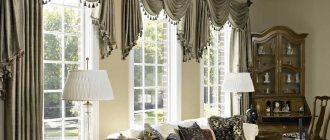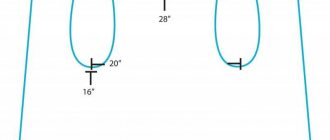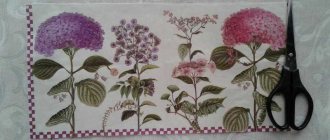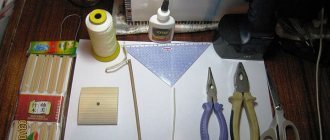It is difficult to imagine a beautiful, complete interior without perfectly matching curtains. The market offers such a wide selection of types and colors of window treatments that you can easily get lost in it. Some resort to the help of designers, while others cope on their own. In the second case, you can pay attention to such a detail as swag. You can make such curtains yourself, the main thing is to stock up on expert advice.
Beautifully decorated window openings can give even the most trivial interior charm and a sophisticated appearance.
Exquisite curtains are not only a decoration for a room, they help create a cozy atmosphere that allows you to rest and unwind after an active day.
What is swag?
Those who are faced with the process of choosing new curtains for the first time often ask the question “What is swag?” Swag is one of the elements that can be used to decorate curtains, namely an addition to the lambrequin (its upper part); it is draped in a special way. It looks like a semicircle with folds on it. It consists of a head and shoulders (some call them wings).
Curtains can look like a real work of art if swags are used to create them.
Depth is the degree of its sagging, length is the length that this element occupies on the cornice. Next comes the middle part - the middle along the cornice. The shoulder is the part with drapery folds and other fabrics. Even when preparing a pattern, you come across the concept of “sag” (the third name is “depth”), this is the length by which the lower part can fall from the upper. Usually the difficulty is in arranging them correctly, but if done correctly, they will become a real highlight in the style of your room.
If you imagine exquisite, expensive curtains, then most likely they will be decorated with a lambrequin with swags.
Swag is used as a decorative component when sewing elegant and luxurious curtains.
Related videos
WATCH VIDEO INSTRUCTIONS
Sewing a swag yourself is not difficult, we have already found out this fact. In addition, mechanical swag is only one of the methods for beginners, which is designed to simplify the sewing process. But after mastering, the result will be charming, and, most importantly, this is a reason to be proud of a product you made yourself. Another plus is that after the first window you will want to redo the rest; skill can only grow and grow over time. Step by step, the sewing business will yield to you and the pieces will begin to come out better. Various video tutorials filmed by professional artists can help you master other techniques. There are many on the Internet, you just need to choose the right one for yourself.
Types: what are they?
Equilateral swag
This is usually used if there are other decorative elements on the curtains, since it does not overload the composition and looks symmetrical, its shoulders are the same.
Swag is used to decorate a window opening.
In order to speed up the sewing process, you can use a ready-made pattern. List of main parameters that must be taken into account when sewing a swag with equal sides:
- Middle;
- Shoulder;
- Depth;
- Bottom sag length.
It is part of a horizontal soft lambrequin, which is designed to give the curtains a sophisticated and sophisticated appearance.
Asymmetrical swag
This species will have different shoulders: one is wider and the other is narrower.
Despite the fact that swags are considered an integral element of the classical style, this does not mean that they are not used in other stylistic directions.
We will describe how to cut and calculate the parameters of the swag. To build this element, you can choose a fabric measuring 140*140, then divide this segment with chalk into two halves diagonally. Then you need to draw lines in both directions that will be equal to half the length of the element; we do this perpendicularly. At the ends of the resulting line we place point No. 1 and point No. 2.
The correct selection of colors and textures will help revive a room decorated in the Art Nouveau and even High-Tech style, bringing its share of the avant-garde.
Important! It is imperative to take allowances into account in order to process the edges later (approximately 05. – 1 cm).
At an angle of 15 degrees from points 1 and 2, you need to set aside segments that will be the same in length as the swag’s shoulder (if you don’t trust your eye, use a protractor). At the ends of the segment you need to put point No. 3 and point No. 4.
“Svag” translated from English means “garland” or “leaf-shaped ornament.”
On the diagonal itself, you need to cancel the sagging depth (let it be marked as point A), connect points A and 3, as well as points A and 4 with an arc. The pattern is ready.
What to sew from
Fashion trends extend to both lambrequins and other textile products. So, in the new season, it is preferable to opt for materials in pastel shades with a noble texture and a simple cut. Discreet and laconic decor will advantageously emphasize the elegance of flowing curtains.
For heavy, thick curtains, the following are suitable:
They will add elegance and respectability to the design of the window opening.
For light and flowing curtains, the following are preferred:
They will create a feeling of airiness and add grace to the interior of the room.
It is necessary to select material for curtains and lambrequins based on the style of the living space. For the living room, you can choose noble velvet or shiny jacquard; for the bedroom, linen and satin would be an excellent solution; for the kitchen, linen, cotton and polyester are ideal. These materials are practical and beautiful, especially when choosing the Provence style.
Do-it-yourself swag: how to make patterns? Step by step description
Sewing this element is a rather complex and multifaceted process. It can take a lot of time to master the art of sewing and become a professional at it, but for beginner seamstresses and hobbyists there are simpler methods by which you can sew a curtain.
It is made in the form of a semicircle, sagging freely, and consists of beautiful draped folds.
You shouldn’t be scared, because according to the instructions of this easy method, anyone can sew such curtains. The whole point is that you can sew not only a classic swag, but also a simpler one to make - a mechanical one. Its peculiarity is that folds can be made not by hand, but by resorting to tricks and using mounting tape, or you can come across such a name as curtain tape. At the same time, it is almost impossible to distinguish this option from the one that was created manually. Therefore, this alternative is not at all inferior to the classical method. So, a small master class on sewing an equilateral swag.
Several swags can be used simultaneously in one lambrequin, which are arranged as if overlapping each other.
Often between them you need to sew an additional decorative element that will fill the resulting space.
Options:
As a standard, these elements are sewn with a height of 35 cm and a width of 60. These dimensions may vary slightly, depending on the size of the window and the desired effect. We will use the following parameters:
- length 90 cm;
- depth 45 cm;
- the bottom sag is 140 cm.
Swags do not always have the same width, for example, the central element may be smaller than the side parts.
From these measurements it turns out that:
A – half (of its middle) – 15cm
B – depth – 45 cm
B – shoulder – 30cm
G – half of the lower sag – 70cm
Being at different heights from the cornice, they form a two-level composition.
You can decide on your own what size your swags will be by slightly editing the patterns.
Scheme
It’s worth making it a rule to make sketches of future lambrequins. This helps to choose the best arrangement of elements and their proportions in accordance with the size of the window, cornice, curtains. It is better to carry out the diagram on a scale, for example, 1:10. In this case, a three-meter lambrequin on paper will be equal to 30 cm.
If you adhere to this rule, it will not be difficult for you to find out any size of the lambrequin component. To do this, you just need to measure it with a ruler or count the number of cells of graph paper and multiply by the scale value.
You can carry out all constructions on a computer in a graphic editor or a specialized program NanoCad, which allows you to obtain drawings, patterns of curtains and their components with sizing.
We create patterns to sew swags
The first step is to construct an angle with vertex (1). From it to the right you need to set aside a segment that will be equal to half the middle + 3 cm for processing. It turns out 18 cm. The second end of this segment will be point No. 4. Next, we also measure a segment from point No. 1, the length of which will be equal to the depth parameter multiplied by k, where k is equal to 2 - 2.5.
Creating a swag is quite a troublesome and painstaking task, but there are easier and simpler options, for example, “shell”.
Additional Information! This indicator depends on the chosen fabric: if we are working with dry fabric that is stiff enough for draping, then it is better that this indicator is equal to 2. But if the fabric is soft and easy to drape, then it is better that in this case k is equal to 2 ,5.
Even a novice craftswoman can drape such an option. It received this name due to its similarity to a sea shell.
Next step: from point two we draw a circle. Instead of a compass, you can use a thread, attaching it to point No. 1. After this, on the resulting arc from point No. 2, mark point No. 3. it should be in half of the lower sag, and, of course, do not forget about the additional 3 cm for processing. We connect points No. 3 and No. 4 with a straight line, and the angle that will be obtained at point 4 will be slightly rounded. As a result of the work done, we get a figure (1-2-3-4) - it will be the basis of our pattern. We will make the stitching of the mounting tape along line 1-4-3, and the tie on section 4-3. The middle (1-4) is not tightened, but only processed.
There are several varieties of this element for decorating window openings, each of which has its own flavor and is characterized by distinctive features.
Usually this element is sewn on a lining, but using soft fabric you can do without it. So, we have half of the pattern ready.
Swags come in a variety of designs, including two-level ones.
Additional Information! In this case, you can cut at an angle of 45 degrees, or you can cut along the warp thread, this is even more convenient.
This type is located in a horizontal plane relative to the entire curtain fabric at the same height.
When you start sewing, work the side that lies between points 2 and 3 using a bias stitch or a double bend. On those sides to which the curtain tape will be sewn (1-4-3), turn the seam allowance inside out and then iron it. From the wrong side we stitch the curtain tape. We tighten side 4-3, and leave the middle (1-4) unstretched. Now the pattern is ready!
This model can also have asymmetrically laid shoulders.
Use a ready-made template
If you are new to this business, in order to properly sew a swag with your own hands, it is better to take ready-made patterns. Now computer technology has greatly simplified search and work.
- Make a pattern in parts on landscape sheets of home printing equipment.
- Order from a company that provides large-format image production services.
In the first case, you will do everything without leaving home, but you will have to glue the sheets with tape. In the second option, you won’t have to connect anything, but you will have to spend extra money.
With the transition to de jabot
Curtains can be made even more unusual and original if you use the technique of transition to de jabot. This option can replace two components of a lambrequin at once; in addition, it allows you to avoid primitive and boring design solutions.
Thanks to the presence of such an element, you can create decorative patterns from curtains, giving the room sophistication and elegance.
Accordingly, the pattern will consist of two parts: the swag pattern, which will be attached to the de jabot pattern. So let's get started.
It is necessary to select the material for such an element with special care, since the entire appearance of the resulting composition depends on it.
- We are building a swag pattern. In the previous paragraphs, we have already looked at how to make a pattern for an asymmetrical and ordinary element.
- We attach an element de jabot to this pattern. How to make a pattern for it? Let's look further.
- On the perpendicular to the fold of the fabric aB from point G1, mark the distance G1D, it will be equal to the length of the finished element de jabot along the cornice, taking into account the folds.
- From point D we draw a perpendicular to line G1D and measure the height of the de jabot on it (in the figure this is point DD1)
- All that remains is to draw the sag line.
If you want the folds of the swag to be soft, then opt for fabric that drapes easily.
The swag pattern with the transition to de jabot is ready!
Curtains and lambrequins: history, classification, cutting and sewing, care, photo galleries
One of the activities of the Cutting Academy is training in cutting and sewing curtains and lambrequins and, accordingly, sewing them for customers.
Training, as a rule, is carried out in the form of one-day seminars in different cities of Ukraine. In the “curtain” section of our website you can find the following information:
History of curtains Classification of curtains Cutting and sewing curtains Caring for curtains Photo galleries of curtains
From the history of curtains
Renaissance art originated in Italy in the 16th century and, having reached its peak in the 16th century, existed in Western and Central Europe until the mid-17th century. When decorating residential premises during this period, different colored tree species and skillful inlays on walls and furniture were used. Rich draperies with large lambrequins are used to decorate windows and doorways. The Renaissance lambrequin is smooth, with appliqué and silk embroidery, trimmed with fringe. There are festoons along the edges of the lambrequin.
The floors of the draperies, also trimmed with fringe, are intercepted at the bottom with a twisted cord. The use of cords and small tassels as decoration elements is generally characteristic of draperies of this time.
The Baroque artistic style (from the Italian barocco - whimsical) originated at the end of the 16th century. in Italy and existed until the middle of the 18th century. The fundamental feature of Baroque is the synthesis of architecture, sculpture and painting. This style is characterized by a fusion of illusion and reality, the sublime and the everyday, a combination of the ideal and the material. The Baroque style is distinguished by rich and spectacular decoration, and the widespread use of lush sculptural decoration. For color solutions, rich tones of blue, green, yellow and red are used in combination with white and gold. In textile interior decoration, such details as numerous bows, draperies, ruffles, interspersed with gold elements, fittings and accessories were used.
The Rococo style is a luxury style. Rococo is characterized by a grandiose interpretation of images and sophisticated decorative effects. Particular attention is paid to the decoration of buildings, and applied art receives significant development. Curtains and curtains become more flirtatious and frivolous, without losing their splendor. When decorating windows with draperies, the dominant role belongs to the lambrequin. Only the upper part of the window is covered with fabric. Rococo style curtains are characterized by the use of silk and light tapestry in light colors. In general, the draperies of this time create a feeling of lightness and elegance. Along the lower edge of the lambrequin, trimmed with gold fringe, there is a desaturated ornament. The same ornament is found on the cornice. In the center the lambrequin is decorated with embroidered roses. Along with curtains, there are also curtains made of light fabric - usually thin silk, less often tulle, trimmed with vertical ruffles. At the bottom, these curtains end with a flounce.
The neoclassical style originated in the late 1700s, thanks to the famous decorator Robert Adam. The choice of fabrics expanded enormously: jacquard, moire, brocade, velvet, voile and muslin were added to silk and damask. The palette of colors and shades was not inferior to the variety of materials - dull turquoise, lilac, pale crimson, pale yellow were in fashion... Cords and tiebacks were actively used, and Thomas Chippendale came up with a carved wooden lambrequin, which gradually turned into a distinctive feature of this entire period.
Empire style. The heroic spirit of military campaigns reigns in the interior. Spear-shaped finials and decorative finishes with eagles, swans, animal heads, and laurel wreaths appear on the cornices. The windows are decorated with paired curtains, most often made of muslin, exquisitely intercepted and fixed in a certain position. Finishing, exquisite ornaments and heavy fringe are used generously. The most popular colors in the Empire era were cherry, dark pink, saffron yellow, blue and pink.
History of curtains Classification of curtains Cutting and sewing curtains Caring for curtains Photo galleries of curtains
Cutting and sewing curtains
Curtain patterns
Equilateral swag Swag, turning into de jabot Classic tie Double swag with a bell De jabot Bell Double bell De jabot with a one-piece bell Classic chill mold Oblique mold
Sewing curtains
Curtains with drawstring Curtains with eyelets Curtains with ties Japanese panels How to lengthen curtains
Product sizing
For the lambrequin to look neat, it must match the size of the window opening.
In this case, you need to take into account the following details:
- The width of the lambrequin should be 20-25 cm longer than the rod on each side. In this case, the product will have a finished look and will provide additional protection from sunlight.
- If you need to make a folded lambrequin, then its width should be equal to the length of the cornice, increased by a factor of 1.3 to 2.
- The height of the product depends on the choice of model and your own preference. By classical standards, the lambrequin should cover 1/3 of the window and the wall above it. But if the ceilings are high, then, naturally, it is not necessary to close the partition.
Accurate calculation of the pattern will save you from various alterations.











